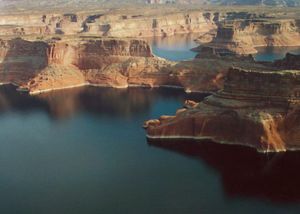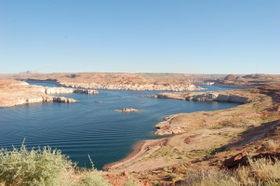Lake Powell
2007 Schools Wikipedia Selection. Related subjects: General Geography
| Lake Powell above Warm Creek Bay | |
| Facts | |
|---|---|
| Start of storage | March 13, 1963 |
| Completion of initial filling | June 22, 1980 |
| Elevation | 1,127 (3,700 ft) |
| Volume (maximum) | 33.304 km³ (26,999,814 acre.feet) |
| Volume (current) | ~ 26.5 km³ (21,483,757 acre.feet) |
| Surface area | 266 mi² |
| Length | 299 km (186 miles) |
| Width | 40 km (25 miles) |
| Shoreline | 3,057 km (1,900 miles) |
| Maximum depth | 170 m (560 ft) |
| Mean depth | 40 m (132 ft) |
Lake Powell is a man-made reservoir on the Colorado River, straddling the border between Utah and Arizona. It was created by the flooding of Glen Canyon by the controversial Glen Canyon Dam, which also led to the creation of Glen Canyon National Recreation Area, a popular summer destination. The reservoir is named for explorer John Wesley Powell, a one-armed American Civil War veteran who explored the river via three wooden boats in 1869. In 1972, Glen Canyon National Recreation Area was established. It is public land managed by the National Park Service, and available to the public for recreational purposes. Lake Powell is arguably one of the most scenic lakes in America, situated in some of Southern Utah's finest red-rock desert country. It is second in size only to Lake Mead downstream. With both lakes storing about 25,000,000 acre-feet (31 km³) of water each when full, the water is a valuable resource for the western U.S. Lake Powell boasts over 1,900 miles (3100 km) of shoreline, more than the entire coast of the western U.S. and has 96 major side canyons.
History
In the 1940s and early 1950s, the U.S. Bureau of Reclamation planned to construct a series of Colorado River dams in the rugged Colorado Plateau province of Colorado, Utah and Arizona. Glen Canyon Dam was born of a controversial damsite the Bureau selected in Echo Park, in what is now Dinosaur National Monument in Colorado. A small but politically effective group of objectors led by David Brower of the Sierra Club succeeded in defeating the Bureau's bid, citing Echo Park's natural and scenic qualities as too valuable to submerge.
But by agreeing to a relocated damsite near Lee's Ferry, between Glen and Grand Canyons, Brower did not realize what he had gambled away. At the time, Brower had not actually been to Glen Canyon. When he later saw Glen Canyon on a river trip, Brower was stunned to discover that it had the kind of scenic, cultural and wilderness qualities often associated with America's finest national parks. Over 80 side canyons in the colorful Navajo Sandstone contained clear streams, abundant wildlife, arches, natural bridges, and thousands of Native American archeological sites. By then, however, it was too late to stop the Bureau and its commissioner Floyd Dominy from building Glen Canyon Dam. Dominy was a firm believer in subduing the river for human use, once saying "Now I admit that nature can't improve upon man. We're probably the supreme being." Brower believed the river should remain free, and would forever after consider the loss of Glen Canyon his life's ultimate disappointment.
Construction on Glen Canyon Dam began with a demolition blast keyed by the push of a button by President Dwight D. Eisenhower at his desk in the Oval Office on October 1st, 1956. The first blast started clearing tunnels for water diversion. On February 11th, 1959, water was diverted through the tunnels so dam construction could begin. Later that year, the bridge was completed, allowing trucks to deliver equipment and materials for the dam, and also for the new town of Page, Arizona.
Concrete placement started around the clock on June 17th, 1960. The last bucket of concrete was poured on September 13th, 1963. Over 5 million cubic yards (4,000,000 m³) of concrete make up Glen Canyon Dam. The Dam is 710 feet (216 m) high, with the surface elevation of the water at full pool being approximately 3700 feet (1100 m). Construction of the Dam cost $155 million, and 18 lives were lost in the process. From 1963 to 1966, turbines and generators were installed for hydroelectricity. On September 22nd, 1966, Glen Canyon Dam was dedicated by Lady Bird Johnson.
Upon completion of Glen Canyon Dam on September 13th, 1963, the Colorado River began to back up, no longer being diverted through the tunnels. Lake Powell was born. As the lake filled over the years, seismic activity in the area increased as the ground shifted beneath the increasing weight of the water. It took 17 years for the lake to rise to the high water mark, on June 22nd, 1980. However, in the heavy snow year of 1983, the lake crested two meters above the high water mark, just two meters below the top of Glen Canyon Dam. In 1964, Glen Canyon Dam was voted Outstanding Engineering Achievement of the year by the American Society of Civil Engineers.
The dam has not lacked for detractors throughout its brief history, however. A segment of the American public objected to the dam's construction and subsequent submerging of Glen Canyon. Many consider the dam a symbol of the price of growth in the West. In the past decade, this controversy has been steadily making news as people continue to contest the dam and push for its decomissioning.
In April 2005, several years of drought reduced Lake Powell to a low 34 percent of capacity. In 2004, Glen Canyon National Recreation Area was forced to close four of its six boat launching facilities, as the receding water left them high and dry. As a sign of the hazards of a low reservoir, some of the closed facilities remained partially available on a "launch at your own risk" basis. Houseboats not frequently moved were stranded by the falling water level. In 2005, the runoff returned to normal. The reservoir rose by 55 feet (17 m), and all the facilities and ramps were reopened. However, 2006 was another dry year, with only about 73% of average runoff. The lake has dropped again, and all but one of the boat ramps are unusable for most boats. A flurry of articles appeared during these years that drew public attention to the chance to see Glen Canyon reemerge from the waters. Many features of Glen Canyon not seen in 40 years were once again available for all to see. It remains questionable whether or not there will be enough water to sustain the lake in years to come.
Geology
Glen Canyon was carved by differential erosion from the Colorado River over an estimated 5 million years. The Colorado Plateau, through which the canyon cuts, arose some 11 million years ago. Within that plateau lie layers of rock from over 300 million years ago to the relatively recent volcanic activity. Pennsylvanian and Permian formations can be seen in Cataract Canyon and San Juan Canyon. The Moenkopi Formation, which dates from 230 million years ago ( Triassic Period), and the Chinle Formation are found at Lees Ferry and the Rincon. Both are the result of the ancient inland sea that covered the area. Once the sea drained, windblown sand invaded the area, creating what is known as Wingate Sandstone. The more recent ( Jurassic Period) formations include Kayenta Sandstone, which produces the trademark blue-black "desert varnish" that streaks down many walls of the canyons. Above this is Navajo Sandstone, the result of more compressed sand dunes. Many of the arches, including Rainbow Bridge, lie at this transition point. This period also includes light yellow Entrada Formations, and the dark brown, almost purple Carmel Formation. These latter two can be seen on the tops of mesas around Wahweap, and the crown of Castle Rock and Tower Butte. Above these layers lie the Straight Cliffs Sandstone and conglomerate shales that make up the Kaiparowits Plateau and San Rafael Swell to the north of the lake.
The confluences of the Escalante River and San Juan River lie within Lake Powell. The slower flow of the San Juan has produced incredible Goose Necks, where 5 miles of river are contained within 1 mile on a straight line.
Features
The lake's main body stretches up Glen Canyon, but has also filled many (over 90) side canyons. The lake also stretches up the Escalante River and San Juan River where they merge into the main Colorado River. This provides access to many natural geographic points of interest as well as some remnants of the Anasazi culture.
- Rainbow Bridge National Monument
- Defiance House ruin
- Cathedral in the Desert ( photos)
- San Juan goosenecks
- Kaiparowits Plateau
- Hole-in-the-Rock crossing
- the Rincon
- Three-Roof Ruin
- Padre Bay
Development
Because most of the lake is surrounded by steep sandstone walls, access to the lake is limited to developed marinas:
- Lees Ferry Subdistrict
- Page/ Wahweap Marina
- Antelope Point Marina
- Halls Crossing Marina
- Bullfrog Marina
- Hite Marina
The following marinas are accessible only by boat:
- Dangling Rope Marina
- Rainbow Bridge National Monument
- Escalante Subdistrict
Glen Canyon National Recreation Area draws more than two million visitors annually. Recreational activities include boating, fishing, waterskiing, jet-skiing, and hiking. Prepared campgrounds can be found at each marina, but many visitors choose to rent a houseboat or bring their own camping equipment, find a secluded spot somewhere in the canyons, and make their own camp (there are no restrictions on where visitors can stay). Anyone who camps further than a quarter of a mile from a marina, however, must bring a porta-potty. The burying of human waste in Glen Canyon National Recreation Area is prohibited. Pet waste must also be packed out.
The southwestern end of Lake Powell can be accessed via U.S. Highway 89 and Arizona State Route 98. Use Utah SR-95 and Utah SR-276 to get to the northeastern end of the lake.



